#reticulated beetle
Text

Bug of the Day
This funky dude is a reticulated beetle, Cupes capitatus. I think this shot is a good view of where the family gets its name - reticulated refers to the lattice-like pattern on the wing covers (technical entomonerd verbiage: "clathrate elytra"). But also, that shrunken nugget of a head is hilarious to me LOL.
#reticulated beetle#Cupes capitatus#Cupes#Cupedidae#beetles#Coleoptera#insect#bug of the day#BotD#entomonerd#clathrate elytra
173 notes
·
View notes
Photo





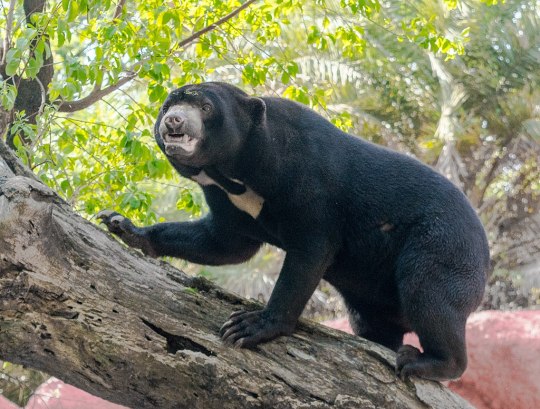


The sun bear is a species of bear in the family Ursidae and the only species in its genus Helarctos which is native to India, Bangladesh, Cambodia, China, Myanmar, Laos, Thailand, Vietnam, Brunei, Indonesia, and Malaysia. Here they are primarily solitary, diurnal, and arboreal creatures which live throughout both tropical deciduous and evergreen forests, and are often found 10 to 30ft off the forest floor and sleep inside tree cavities or under fallen logs. Sun bears are omnivores with a broad diet which includes nuts, fruit, seeds, sap, leaves, eggs, honey, nectar, grubs, bees, ants, beetles, termites, spiders, small birds, reptiles, and small mammals. Sun bears are themselves preyed upon by tigers, leopards, dholes, and reticulated pythons. Reaching 3- 4.5 ft (1- 1.3m) in length, and 55 -145lbs (25 to 65 kg) in weight, the sun bear is the smallest of all bear species. It is stockily built, with large paws, strongly curved claws, small rounded ears and a short snout. The fur is generally jet-black, but can vary from grey to red. Sun bears get their name from the characteristic orange to cream colored chest patch. Sun bears also sport inward facing paws better suited to climbing and incredibly long tongues which they use when feeding upon insects, honey, sap, and nectar. Sun bears are noted for their intelligence; with several individuals being observed to raid locked sugar store rooms by retrieving the keys and/ or picking the locks. Sun bears are polyoestrous; with breeding occurring year round. After a 95-240 day pregnancy (dependent on number of cubs) the mother will give birth to 1-3 cubs which will remain with there mother for up to 3 years. Under ideal conditions a sun bear may live upwards of 30 years.
5 notes
·
View notes
Text
Fossil Friday: Insects Part 1
Fossil Friday: Insects Part 1

Insects and their fellow creepy crawlies have been around for a long, long, looongtime. Long before dinosaurs ever showed up on stage. A common misconception is that creepy crawlies in prehistoric times were limited to just dragonflies, millipedes, and perhaps spiders, and they were all giant. I’m thinking about a certain eagle-size dragonfly and six-foot long millipede in particular. But there…
View On WordPress
#beetles#click beetle#fossil friday#Insects#jewel beetle#Jurassic#jurassic beetle#Jurassic bug#jurassic insect#leaf beetle#netwing beetle#prehistoric#reticulated beetle#rove beetle#scarab beetle#water beetle#Weevil
0 notes
Text





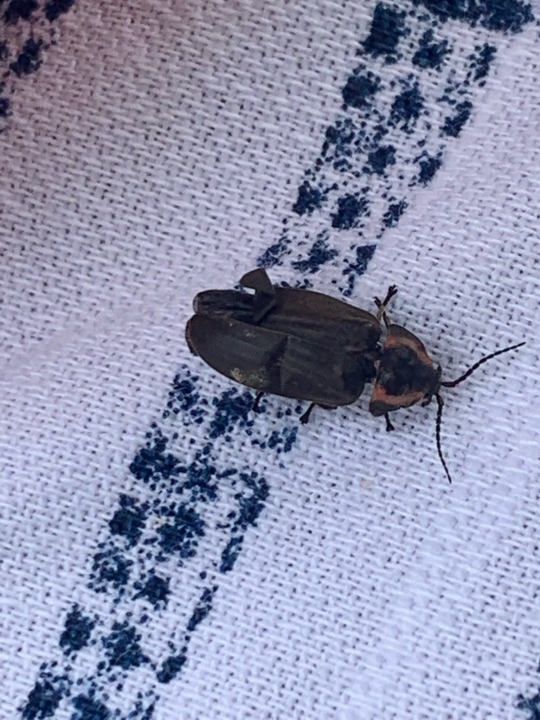
@my-whole-brain-is-crying submitted: these three bugs are all from pennsylvania if you could please id them. the last one is injured sadly, it's wing is bent
Suuure. The first dude is a mayfly but it's not clear enough to really tell you which one. The first beetle is a net-winged beetle in the genus Calopteron, likely C. reticulatum, I think. The injured friend looks like a winter firefly, Ellychnia corrusca :)
#insects#bugs#submission#animals#mayfly#beetle#net winged beetle#reticulated net winged beetle#firefly beetle#winter firefly#injured bug
47 notes
·
View notes
Text


I haven’t updated my species headcanon for Kopius for a reason
(I am in massive denial)
#nsfw???#suggestive#not art#shitpost#no disrespect intended to my european followers I'm just being dramatic lmfao#insektors#anyways in other news maybe Kopius can be a reticulated stag beetle#they do have antennae kinda like his... just more subtle#once again the denial is rlly strong here huh
2 notes
·
View notes
Text
Detective Reticulated giraffe attempts to deduce what type of animal Godzilla-Chan is

Hmm...
Pitch black, aren't you?...
And there are spiny things growing from your back....
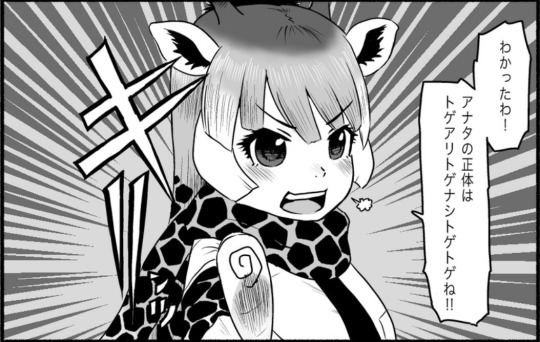
“Eureka! Your true identity is a Spined Spineless Spiny-Spiny, isn't it?!!”
The Japanese name for leaf-mining beetles (subfamily Hispinae) is "spiny leaf-beetles" (toge hamushi), but they used to have the alternate name "spiny-spiny" (togetoge). A few species of leaf-mining beetles have no spines, leading to the amusing name of "spineless spiny-spiny" (although the preferred term is hosohirata hamushi, "thin flat leaf-beetle") ...and sure enough, a species of hosohirata hamushi with spines was recently discovered in Southeast Asia, and promptly nicknamed the "spined spineless spiny-spiny" (togeari togenashi togetoge).
The beetles in question
spineless spiny-spiny
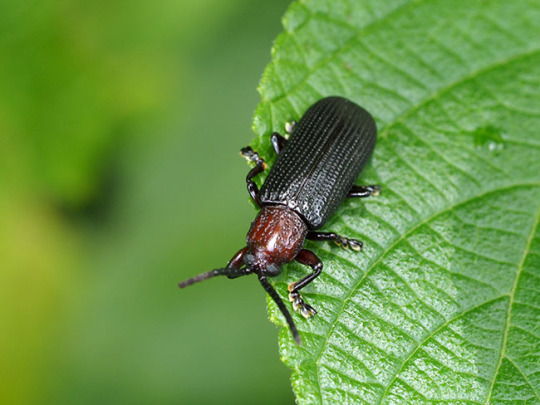
spined spineless spiny-spiny
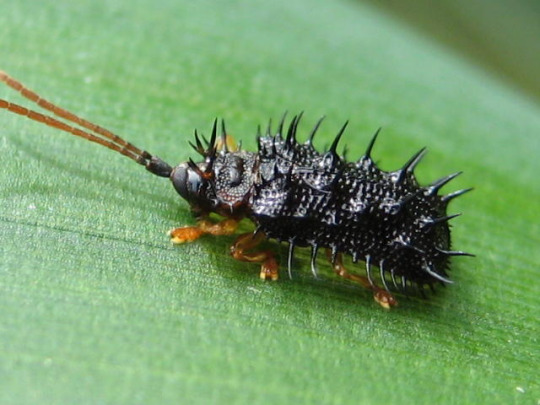
By the way, non-tetrapods cannot become Friends canonically.
So this is even worse than when Detective Giraffe “deduced” that Serval was a former goat.
34 notes
·
View notes
Text
Morganucodon

By Scott Reid
Etymology: Tooth from Glamorgan (a county in Wales)
First Described By: Kühne, 1949
Classification: Biota, Archaea, Proteoarchaeota, Asgardarchaeota, Eukaryota, Neokaryota, Scotokaryota Opimoda, Podiata, Amorphea, Obazoa, Opisthokonta, Holozoa, Filozoa, Choanozoa, Animalia, Eumetazoa, Parahoxozoa, Bilateria, Nephrozoa, Deuterostomia, Chordata, Olfactores, Vertebrata, Craniata, Gnathostomata, Eugnathostomata, Osteichthyes, Sarcopterygii, Rhipidistia, Tetrapodomorpha, Eotetrapodiformes, Elpistostegalia, Stegocephalia, Tetrapoda, Reptiliomorpha, Amniota, Synapsida, Eupelycosauria, Sphenacodontia, Sphenacodontoidea, Therapsida, Eutherapsida, Neotherapsida, Theriodontia, Eutheriodontia, Cynodontia, Probainognathia, Chiniquodontoidea, Prozostrodontia, Mammaliaformes, Morganucodonta, Morganucodontidae
Referred Species: M. watsoni, M. oehleri, M. tardus, M. peyeri, M. heikuopengensis
Status: Extinct
Time and Place: Morganucodon is known from the Kayenta Formation of Arizona, the Forest Marble Formation of England, the Varangeville Conglomerate of France, the Gruhalde Member of the Klettgau Formation of Austria, and the Lufeng Formation of Yunnan, China. Please note that only the Chinese, Austrian, and French locations are of Triassic origin.

Morganucodon lived from the Rhaetian of the Late Triassic to the Bathonian Middle Jurassic of Eurasia, from around 205 million years ago until 167 million years ago.

Physical Description: While Morganucodon itself is not known from many body fossils, its appearance can be inferred from its relatives, such as Megazostrodon, that have been better preserved. Its body would have been elongated and low to the ground, somewhat resembling a shrew. It may have sprawled somewhat with its forelimbs, but its hind legs and hips were much closer to those of mammals. Morganucodon’s skull was long and flat on top. It had two types of teeth, premolars and molars, similar to later mammals. The mammaliaform also replaced its teeth once in its lifetime: it had “baby” (or “milk”) teeth and “adult” teeth, like its modern relatives.
Diet: Morganucodon was almost certainly insectivorous. Study of its teeth showed that its jaws could stand up to more stress and that its bite was relatively forceful, allowing members of the genus to hunt “tougher” prey items than its contemporaries. It may have eaten beetles, which are known from its environment.
Behavior: These animals were probably nocturnal, as evidenced by heightened senses of hearing and smell, as well as comparisons with similar modern animals.
Ecosystem: Due to its wide distribution, Morganucodon would likely have inhabited a range of environments. The first fossils were discovered in what were once fissures on an early Jurassic or late Triassic limestone island, St. Bride’s Island. It was a small landmass of about 20 square km (7.7 square mi) with a karst environment of sinkholes and caves. It would also have been warm, supporting plants such as clubmosses, bennetites, ferns, and cycads. Morganucodon would have shared its environment with other mammaliaforms, such as Kuehneotherium, and as such likely experienced niche partitioning (different species occupying different niches in ecosystems, which reduces competition). Other animal species known from the same areas include ancient reticulated beetles, the sphenodontian Gephyrosaurus, and another mammal relative, Oligokyphus.
The Swiss fossils were unearthed in marine deposits, though it is likely that it was washed out to sea. Other terrestrial animals known from these beds include the pterosaur Peteinosaurus, the trilophosaur Variodens, a few rhynchocephalians, and several species of cynodonts. The environment of the French specimens is less well-documented, but likely similar, with therapsids, temnospondyl amphibians, pterosaurs, and phytosaurs all being documented.
Other: This small mammaliaform has helped to illuminate the evolution of mammalian ears. Our lower jaws, and those of our modern mammalian cousins, are unique in that they are made up of only one bone: the mandible. In other animals, this structure is made up of multiple different bones, which are used to help with chewing. Somewhere along the line in mammal evolution, most of our lower jaw bones shrunk in size and moved to our ears, enabling us to have a complex system of hearing. Morganucodon represents an intermediate step in this process: it still had many of the jaw bones of more basal amniotes, albeit much more reduced.
It would also likely have been warm-blooded, as evidenced by its secondary palate. This feature of the skeleton separates the nasal cavity from the mouth, allowing animals with it to quickly breathe while using their mouths for feeding. Morganucodon also had a bone structure that suggested rapid growth. Other shared traits with modern mammals include the likely presence of mammary glands and a relatively large brain.
~ By Jasper Barnes
Sources under the Cut
Benton, Michael J. (2015). Vertebrate Palaeontology (fourth edition). Wiley Blackwell.
Butler, Percy M., Sigogneau-Russell, Denise (2016). Diversity of triconodonts in the Middle Jurassic of Great Britain. Palaeontologia Polonica 67, 35–65.
Evans, S. E. (1992). Small reptiles and amphibians from the Forest Marble (Middle Jurassic) of Dorset. Proceedings of the Dorset Natural History and Archaeological Society 113:201-202
Fraser, Nicholas (2006). Dawn of the dinosaurs: life in the Triassic. Indiana University Press.
Gill, Pamela G., Purnell, Mark A., Crumpton, Nick., Robson Brown, Kate, Gostling, Neil J., Stampanoni, M., and Rayfield, Emily J. (2014). Dietary specializations and diversity in feeding ecology of the earliest stem mammals. Nature 512, 303–305
Godefroit, P. (1997). Reptilian, therapsid and mammalian teeth from the Upper Triassic of Varangéville (northeastern France). Bulletin de l'Institut Royal des Sciences Naturelles de Belgique, Sciences de la Terre 67:83-102
Peyer, B. (1956). Über Zähne von Haramiyiden, von Triconodonten und von wahrscheinlich synapsiden Reptilien aus dem Rhät von Hallau, Kt. Schaffhausen, Schweiz [On the teeth of haramiyids, triconodonts, and probable synapsid reptiles from the Rhaetic of Hallau, Kanton Schaffhausen, Switzerland]. Schweizerische Paleontologische Abhandlungen 72:1-72
Walter G. Kühne, "On a Triconodont tooth of a new pattern from a Fissure-filling in South Glamorgan", Proceedings of the Zoological Society of London, volume 119 (1949–1950) pages 345–350
#Morganucodon#Mammaliaform#Mammal#Triassic#Palaeoblr#Triassic Madness#Triassic March Madness#Morganucodon watsoni#Morganucodon oehleri#Morganucodon tardus#Morganucodon peyeri#Morganucodon heikuopengensis#Prehistoric life#Prehistory#Paleontology
178 notes
·
View notes
Photo
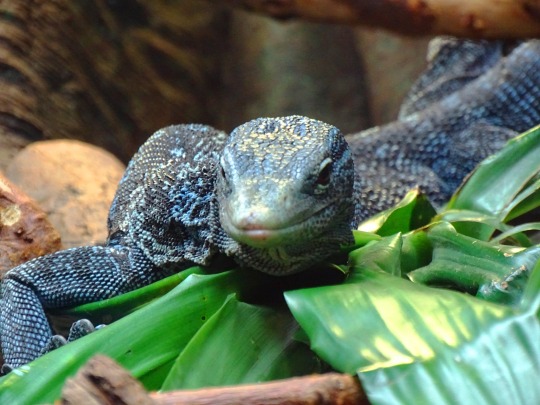


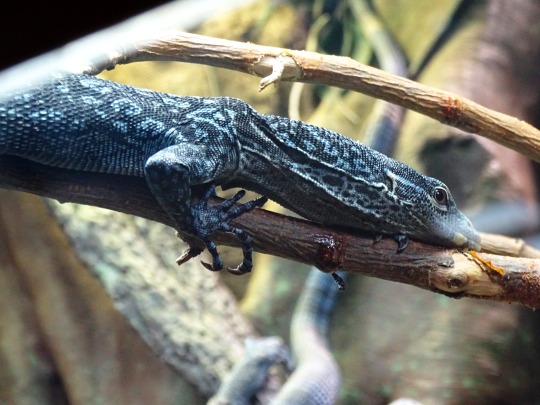
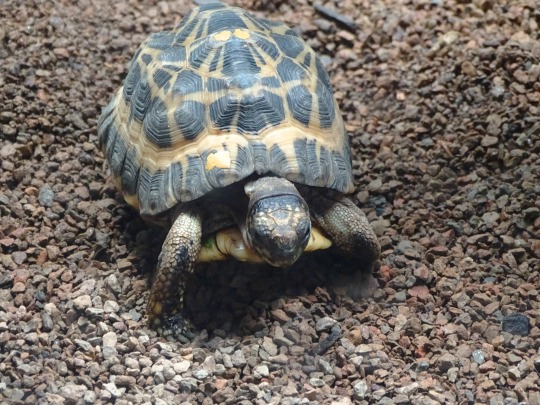





Bronx Zoo, New York City (No. 22)
Varanus macraei, the blue-spotted tree monitor or blue tree monitor, is a species of monitor lizard found on the island of Batanta in Indonesia. It is named after herpetologist Duncan R. MacRae, founder of the reptile park Rimba on Bali.
Varanus macraei is part of the prasinus-group and the subgenus (Euprepiosaurus). As its common names suggest, it is black with scattered blue scales, forming ocellations that may in turn form bands across the back. The tip of the snout is light blue and the lower jaw is white with uniform green scales along the neck, forming a v-shaped pattern. There are less than 9 dorsal crossbands and the legs are heavily spotted with turquoise ocelli. There are 85–103 scale rows at midbody. A single distinct blue scale row stretches from the lower angle of the eye to the upper edge of the ear. Its throat is light with dark spots forming a reticulated pattern. Like all members of the prasinus-group, with 22–23 more or less symmetrical blue rings, the tail is prehensile and about 1.95 times as long as the snout-vent length (SVL). Male blue-spotted monitors reach a larger maximum size than female blue-spotted monitors, and they can be distinguished by the comparatively broader temporal region and distinct hemipenal bulges posterolateral to the cloaca. Adult male blue-spotted monitors may reach 3.5 ft (1.1 m) in total length, and female blue-spotted monitors are about 4 in (10 cm) shorter than the male blue-spotted monitors, making V. macraei the largest known species of the V. prasinus complex.
This species is diurnal and arboreal thus it avoids predators by fleeing up a tree and keeping the trunk between itself and the intruder, as many anoles do. Currently no studies have been published on the matter, however the diet of V. macraei is likely primarily made up of (in order) stick insects, orthopterans (grasshoppers, katydids and crickets), moths, beetles, smaller lizards, small eggs, and the occasional berry.
Source: Wikipedia
#Komodo dragon#reptile#Bronx Zoo#my favorite zoo#New York City#USA#travel#original photography#summer 2018#animal#Madagascar!#blue-spotted tree monitor#Varanus macraei#blue tree monitor#lizard#vacation#flora#fauna#nature#detail#head#Coquerel's sifaka#Northeastern USA#Ring-tailed lemur
7 notes
·
View notes
Photo
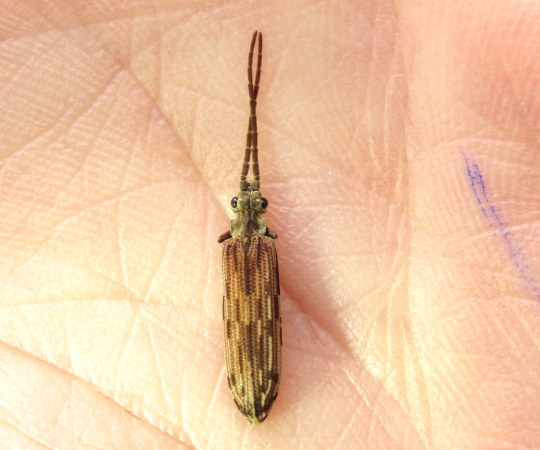

Bug of the Day
IDK why, but in my head this photo is called “My Friend Likes to Draw on His Hand.” Makes *ZERO* sense because that marker looks accidentally applied. Anyway, thanks friend, for holding this reticulated beetle (Tenomerga cinerea) who desperately wanted us to believe it was dead :-).
205 notes
·
View notes
Link
Beetles are in the insect order of Coleoptera, which is the largest order of insects. Forty percent of all insects are beetles. In fact, beetles make up almost 25 percent of all existing animal life. There are more than 350,000 species of beetles worldwide, and possibly more if you factor in species that are not yet discovered. These are divided into 4 basic subgroups – Archostemata, which are wood boring ‘telephone-pole’ beetles and reticulated beetles, which have a distinct pattern of squares on their outer shell; Adephaga, which are bark beetles, ground beetles and most...
0 notes
Text
Services Offered By Pest Control Companies

When buying a house, you do everything just to find the best one. It should be safe, fits your budget, and accommodates you and your family's needs. One safety concern that you should immediately check is if the house is free of pests. This is absolutely important if you want to live a healthy and comfortable life. You wouldn't want your kids to be bitten by ants, or your house's foundation to be infested with termites, right? To make sure that you're not throwing away your money on a property that is pest infested, consider requesting for a building and pest inspection.
A pest inspection will help you determine if the house is a good investment. If you have chosen a property that sits in an area where pests are common, you'd have to do the inspection immediately. Beetles, silverfish, termites, ants, wasps, moths, fleas and the likes have no room in your new home so don't even think twice about getting it checked. Should you be living alone, ensuring that your home is pest free is still a must especially if you plan to sell the property in the future. It will be a lot harder to get the house out of your hand if you have pests as houseguests Orlando Pest Control .
Fortunately, there are many pest control companies offering different services so finding one will not be problem. Here are the most common services they offer:
1. Before purchase pest inspections are a kind of pest control service recommended for all people who plan to buy a house. This is done through contacting a member of the Pest Managers Association to do the inspection and declare whether the house is free from pests or not.
2. Protection for new homes and home extensions. In case the house you bought is declared pest free, you can still use this service to safeguard your furniture. Protect your couch, cabinets and armoires from destructive termites. The experts will apply a chemical to your furniture, and this will keep those unwanted critters away. Some of the usual methods they use are termite barriers and reticulation systems
0 notes
Text
Wildlife at Smith: Invertebrate Edition
One of my favorite parts of Smith is the amazing diversity of wildlife you can find right on campus. Smith’s campus is technically an arboretum, with a huge diversity of plants and trees. These attract some beautiful birds, mammals, and, best of all...bugs!
I know what you’re thinking. “Sylvie, no one wants to hear about what kind of bugs there are at Smith.” Well, hypothetical straw man, I think you’re wrong. As much as I would love to encourage everyone to grow their appreciation of creepy-crawlies like spiders and centipedes, this post won’t feature any stereotypically “freaky” bugs. Instead, here are seven of the coolest or cutest bugs you can find right on campus. (All photos taken by me with my phone!)
1. Hickory Tussock Moth Caterpillar

Aww, look, how fluffy! These cutie pies are common sights on trees around Massachusetts. However, although they look soft, it’s not recommended that you handle these guys, as their hairs contain a toxic compound that can cause rashes in humans. Look, but don’t touch!
2. Northern Katydid
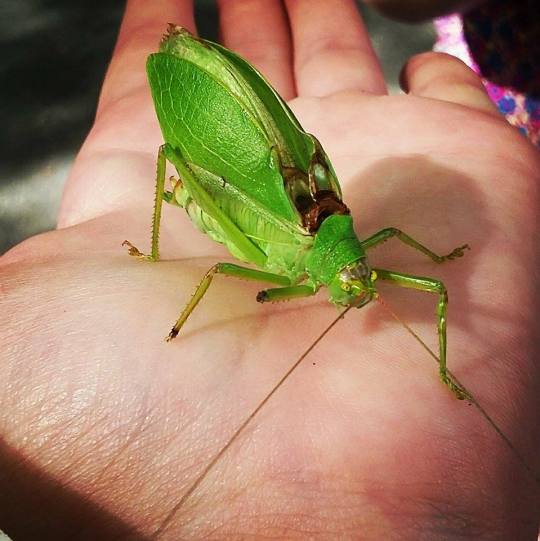
These amazing critters mimic leaves so well that you’ll rarely see them! I only caught sight of this guy because he happened to be hobbling along a sidewalk. Katydids are related to crickets and grasshoppers, and are able to make a loud, piercing call.
3. Reticulated Net-Winged Beetle

Look at this beauty! These common beetles are harmless orange-and-black insects that are commonly seen in the late summer and early fall. Normally, they keep their wings folded together, but I happened to snap a picture of this one right as she was taking off in flight.
4. North American Millipede

Millipedes are one of our most beneficial resident arthropods. They are natural composters who hang out in the soil and clean up dead leaves. They are also perfectly harmless--most will curl up into a ball if you startle them, but as you can see, this little guy was curious enough to crawl all over my hand.
5. Chinese Mantis

As one of the biggest bugs you’ll find in the U.S., praying mantises are an impressive sight! These lovely creatures are a great benefit to gardens and greenhouses, as they eat lots of smaller plant-destroying critters, like aphids. This particular species is fairly common on Smith campus, and is easily recognizable by its brownish body and green striped wing.
6. Red Saddlebags Skimmer Dragonfly

This gorgeous red dragonfly is commonly seen near the river on hot days. Dragonflies are difficult to photograph because they are incredibly skittish. They have fantastic eyesight and an ability to discriminate between colors that is far superior to humans and most other animals. In other words, they usually see you before you see them!
7. Stag Beetle

I saved this guy for last, because I think he’s the most amazing creature you could possibly find on campus! These shiny beetles are reclusive and nocturnal, so consider yourself very lucky if you ever get to see one--this one here is the only one I’ve had the opportunity to see. Although their huge mandibles look menacing, stag beetles are actually herbivores, and generally only use their jaws for courtship and combat with other males.
That’s all the bugs I’ll bore you with for now! It was so hard to narrow this list down to only seven bugs, as there are so many awesome ones you can find if you look closely! I hope you’ve gained at least a little appreciation for the awesome diversity of animals we have on campus, and maybe you can impress your friends by referring to them by name.
10 notes
·
View notes
Text
How I Get Interested in Animals
When I was a young boy. My father used to bring me to the farm to harvest vegetables and fruits for us to sell in the market. In everyday life. While in the farm. There has been a lot of creatures that made me happy. So I stored them in a jar.
Because of healthy soil and environment . Exotic creatures are seen throughout the land. Some Snakes, Scorpions, and Lizards. Because of that I become more interested in insects and animals.
1. Beetles- this is my first insect that I’ve collected when I was a young boy.
2. Guinea Pig- this is my first furry pet.
3. Rabbit- this is my second furry pet and it is so adorable.
4. Lizard- this is my first reptile pet.
5. Hamster and mice- they are my present pet, they are so hyper and they are so cute when they cleaning up themselves.
6. Reticulated python- this is my second reptile pet. and his name is SAWAdeeka but sadly he died.
7. Tarantulas and scorpions- they are now my new pet. Since I was in Senior High School I already taking care of this arachnids. And also because of the influence of my classmate , I started to get more interest in this kind of pet.
#bsbio15Natanawan
0 notes
Text
Services Offered By Pest Control Companies
When buying a house, you do everything just to find the best one. ants removal service should be safe, fits your budget, and accommodates you and your family's needs. One safety concern that you should immediately check is if the house is free of pests. This is absolutely important if you want to live a healthy and comfortable life. You wouldn't want your kids to be bitten by ants, or your house's foundation to be infested with termites, right? To make sure that you're not throwing away your money on a property that is pest infested, consider requesting for a building and pest inspection.
A pest inspection will help you determine if the house is a good investment. If you have chosen a property that sits in an area where pests are common, you'd have to do the inspection immediately. Beetles, silverfish, termites, ants, wasps, moths, fleas and the likes have no room in your new home so don't even think twice about getting it checked. Should you be living alone, ensuring that your home is pest free is still a must especially if you plan to sell the property in the future. It will be a lot harder to get the house out of your hand if you have pests as houseguests.
Fortunately, there are many pest control companies offering different services so finding one will not be problem. Here are the most common services they offer:
1. Before purchase pest inspections are a kind of pest control service recommended for all people who plan to buy a house. This is done through contacting a member of the Pest Managers Association to do the inspection and declare whether the house is free from pests or not.
2. Protection for new homes and home extensions. In case the house you bought is declared pest free, you can still use this service to safeguard your furniture. Protect your couch, cabinets and armoires from destructive termites. The experts will apply a chemical to your furniture, and this will keep those unwanted critters away. Some of the usual methods they use are termite barriers and reticulation systems.
0 notes